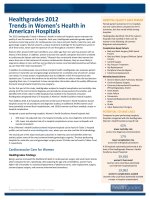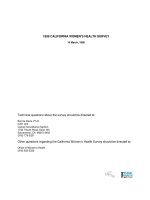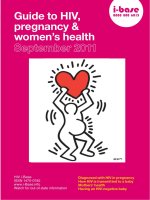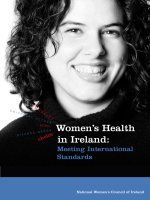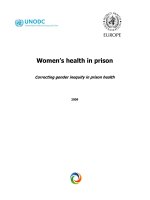Chapter 006. Women''''s Health (Part 2) ppsx
Bạn đang xem bản rút gọn của tài liệu. Xem và tải ngay bản đầy đủ của tài liệu tại đây (11.69 KB, 5 trang )
Chapter 006. Women's Health
(Part 2)
Women's risk for many diseases increases at menopause, which occurs at a
median age of 51.4 years. In the industrialized world, women spend one-third of
their lives in the postmenopausal period.
Estrogen levels fall abruptly at menopause, inducing a variety of
physiologic and metabolic responses. Rates of cardiovascular disease increase and
bone density begins to decrease rapidly after menopause.
In the United States, women live on average about 5 years longer than
men, with a life expectancy at birth in 2004 of 80.4 years, compared to 75.2 years
in men.
Elderly women outnumber elderly men, so that age-related conditions,
such as hypertension, have a female preponderance. However, the difference in
life expectancy between men and women has decreased an average of 0.1 year
every year since 1980, and, if this convergence in mortality figures continues, it is
projected that mortality rates will be similar by 2054.
Women's perception of disease risk is often inaccurate. Public awareness
campaigns have resulted in almost 50% of U.S. women knowing that
cardiovascular disease is the leading cause of death in women.
Nevertheless, the condition they fear most is breast cancer, despite the fact
that death rates from breast cancer have been falling since the 1990s. In any given
decade of life, a woman's risk for breast cancer never exceeds 1 in 34. Although a
woman's lifetime risk of developing breast cancer if she lives past 85 years is
about 1 in 9, it is much more likely that she will die from cardiovascular disease
than from breast cancer. In other words, many elderly women have breast cancer
but die from other causes.
Similarly, a minority of women are aware that lung cancer is the leading
cause of cancer death in women. These misconceptions are unfortunate as they
perpetuate inadequate attention to modifiable risk factors, such as dyslipidemia,
hypertension, and cigarette smoking.
Physicians are also less likely to recognize women's risk for cardiovascular
disease. A survey of physicians in 2004 found that women with intermediate risk
for cardiovascular disease, according to Framingham risk score, were significantly
more likely to be assigned to a lower risk category than men with similar risk
profiles.
Moreover, when presented with actors portraying patients with chest pain,
physicians' estimates for probability of coronary heart disease (CHD) were
significantly lower for women than for men and lower for black women than for
white women. These perceptions on the part of both the patient and her physician
lead to important differences in cardiac care.
Alzheimer's Disease
(See also Chap. 365) Alzheimer's disease (AD) affects approximately twice
as many women as men. Because the risk for AD increases with age, part of this
sex difference is accounted for by the fact that women live longer than men.
However, additional factors likely contribute to the increased risk for AD in
women, including sex differences in brain size, structure, and functional
organization. There is emerging evidence for sex-specific differences in gene
expression, not only for genes on the X and Y chromosomes but also for some
autosomal genes.
Estrogens have pleiotropic genomic and nongenomic effects on the central
nervous system, including neurotrophic actions in key areas involved in cognition
and memory. Women with AD have lower endogenous estrogen levels compared
to women without AD. These observations have led to the hypothesis that estrogen
is neuroprotective.
Some studies have suggested that estrogen administration improves
cognitive function in nondemented postmenopausal women as well as in women
with AD, and several observational studies have suggested that postmenopausal
hormone therapy (PHT) may decrease the risk of AD.
However, recent placebo-controlled trials have found no improvement in
disease progression or cognitive function after up to 15 months of PHT in women
with AD.
Further, the Women's Health Initiative Memory Study (WHIMS), an
ancillary study in the Women's Health Initiative (WHI), found no benefit
compared to placebo of estrogen alone [combined continuous equine estrogen
(CEE), 0.625 mg qd] or estrogen with progestin [CEE, 0.625 mg qd, and
medroxyprogesterone acetate (MPA), 2.5 mg qd] on cognitive function or the
development of dementia in women 65 years and older.
Indeed, there was a significantly increased risk for both dementia and mild
cognitive impairment in women receiving hormone therapy. The possible
explanations for the discrepant results between the observational studies and the
randomized clinical trials remain unclear (Chap. 342).

